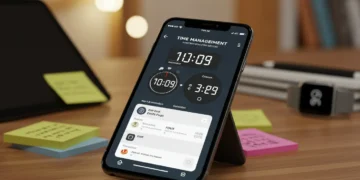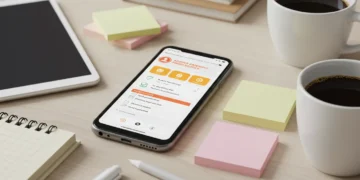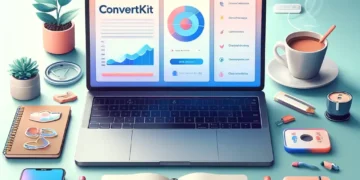Productivity Apps for Focus & Organization
Keeping concentration and order can be a real head-scratcher for students with ADHD. But worry not—there’s a handful of nifty productivity apps that can keep chaos in check. Let’s check out some handy tools and strategies that’ll make a world of difference.
Dragon Dictation for Text Conversion
Dragon Dictation is your go-to buddy for turning talk into text, perfect for folks who find typing a hassle. With ADHD in the mix, this app swoops in to save the day, converting spoken thoughts into written gold. It’s a champ for note-taking, essay writing, or emailing.
- Ease of Use: Just start yapping, and watch your words turn into text like magic.
- Integration: Shuffle the text to other apps, shoot it off in an email, or stash it for later.
- Accessibility: Great for those who spill the beans better than putting pen to paper.
Peek at more helpful tools on our ADHD study tools list for extra study power.
| Feature | What’s it Do? |
|---|---|
| Voice Recognition | Turns talk into text, easy-peasy |
| Multi-Platform | Works on all sorts of gadgets |
| Custom Commands | Make your own voice shortcuts |
| Easy Export | Move text to other places without sweat |
Distraction-Free Study Zones
Crafting a study spot without distractions is key to keeping laser-focused, especially for ADHD students. Here’s how to make your study den just right:
- Clear the Junk: Ditch distractions like social media and unrelated tasks (Concordia University St. Paul).
- Tidy Space: Organize with folders for papers and computer files, so coursework is a snap to find.
- Snug Yet Stimulating: Keep it comfy without turning it into a nap trap. It should be inviting enough to keep you motivated (Northlake Behavioral Health System).
- Scheduled Time-Outs: Sprinkle in breaks to recharge the brain cells (Concordia University St. Paul).
- Routine Groove: A regular study routine is your secret weapon for time management (Northlake Behavioral Health System).
Want more on taming time? Check out ADHD apps for time management.
| Approach | Perks |
|---|---|
| No Distractions | Better focus and less wandering off |
| Tidy Space | Easier access with everything in its place |
| Snug but Stimulating | Keeps you alert and on task |
| Scheduled Time-Outs | Keeps energy up and fingers typing |
| Routine Groove | Smarter use of hours, day in, day out |
By getting the right apps and pimping your study setup, ADHD students can jazz up their study life. Besides Dragon Dictation and a killer workspace, diverse ADHD student organization apps can keep you on top of things and in check.
Strategies for Effective Online Learning
Figuring out online learning can be a bit tricky for students with ADHD, but the right moves can really help boost focus, time usage, and getting things done.
Organizing Study Spaces
A tidy study space really helps students with ADHD keep their heads in the game. Making sure there are no distractions around is a big plus for concentration on schoolwork (Concordia University St. Paul). Here’s how you can make it happen:
- Pick Your Study Spot: Find a special place at home just for studying. Toss out clutter and make it comfy—you’ll be surprised at how much better you can focus.
- Stay Organized: Use filing folders to keep your papers neat and within reach. A tidy area with clearly labeled folders helps you keep track of homework and notes.
- Digital Tidy-Up: Sort your computer files so that finding your coursework is a breeze. Create categories for every subject or project.
| Tips for Organizing Study Spaces | What’s It About? |
|---|---|
| Dedicated Study Area | A cozy, quiet corner for hitting the books |
| Filing Folders | Keep your paperwork and notes nice and neat |
| Computer Folder Structure | Quick and easy access to all your digital stuff |
Blocking distractions, steering clear of social media, and making your spot comfy and inviting can really ramp up how much you get done. Want more tips on staying on top of things? Peek at our piece on ADHD student organization apps.
Scheduled Breaks for Recharging
Taking breaks isn’t just nice—it’s super important for ADHD students. They help refresh and keep the productivity mojo flowing during study marathons. Studies underline the big deal of taking breaks to stay sharp and get the most out of studying (Concordia University St. Paul).
- Pomodoro Trick: Work for a while—say 25 minutes—then take a 5-minute breather. Do this four times, then relax for a longer stretch.
- Reminder Alarms: Set alarms or timers so you know when it’s break time.
- Get Moving: Add in some physical activities during your time outs, like doing some stretches or a quick jog, to perk up.
| Break Technique | What’s It About? |
|---|---|
| Pomodoro Technique | Hit the books for 25 mins, chill for 5 mins |
| Alarms | Break timers that won’t let you forget |
| Physical Activity | Stretches or quick walks to get energized |
Trying these methods can help ADHD students sharpen their focus and build solid study practices, leading to more wins in school. For more tips on nailing study plans, check out our chat on ADHD apps for time management.
Tools for ADHD Students
Having the right kind of help can turn a tough school day into a smoother ride for students with ADHD. Two key areas to zero in on are managing behavior in class and getting a grip on organization.
Behavior Classroom Management
Taming that classroom beast called behavior can do wonders. It’s all about encouraging the good stuff with high-fives or gold stars and giving a gentle nudge away from the not-so-great stuff (CDC). This can really get ADHD kiddos more into their school groove.

Easy Peasy Behavioral Tips:
- Spill the Beans: Teachers need to spell out exactly what’s cool and what’s not, both for behavior and hitting those books.
- Instant Karma: Pat on the back time! Let students know right away when they’re getting it right.
- Everyday Check-ins: Keep the folks in the loop with what’s going on, using a daily report card to show what’s good and what needs some love.
- Golden Carrots: A little reward goes a long way in keeping the motivation train chugging along.
| Management Tool | What it Does | Why It’s Great |
|---|---|---|
| Daily Report Card | Monitors daily vibes and school work | Quick fixes, keeps parents in the loop |
| Reward System | Sweetens the good behavior pot | Pumps up motivation and involvement |
For more ways to help out students with ADHD, check out our article on ADHD study tools.
Organizational Training
Getting organized is like wearing the right shoes for a marathon – it’s essential for making it through school without tripping. This training helps ADHD students juggle their time, plan smartly, and keep track of all their school stuff.
Organization 101:
- Time Magic: Learn the secrets of setting study times, chunking tasks into bite-sized pieces, and using timers like a boss.
- The Planning Wizard: Plot out a week’s worth of things to do and stick to those dates.
- Tame the Mess: Find ways to keep tabs on notes, homework, and school supplies, so nothing goes missing.
Go-To Organization Hacks:
- Time Keeper Apps: Helpers like Todoist or Google Calendar are the best buds for plotting out time and keeping on top of it.
- Old School Tools: Planners and notebooks? Yes, please! Perfect for noting down homework and due dates.
| Training Method | What it Does | Why It’s Awesome |
|---|---|---|
| Time Management Apps | Digital goodie bags for scheduling and reminders | Makes planning a breeze and kicks procrastination to the curb |
| Physical Planners | Classic tools for marking assignments and deadlines | Easy-peasy visual cues and grab-and-go simplicity |
Getting skilled at organization is like having a secret weapon for success with ADHD. For a cool stash of tips and tools, dive into our guide on ADHD student organization apps.
It takes a village, right? Schools, folks at home, and doctors all need to team up to give ADHD kids the support they need (CDC). Chatting openly, fitting tasks to their abilities, and customizing plans can make all the difference. For even more hands-on advice, have a peek at our topics on stay organized ADHD apps and ADHD apps for time management.
Digital Tech in Education
Helping students with ADHD has gotten a high-tech boost thanks to digital gadgets. These tools aren’t just shiny toys; they’re real game-changers in the classroom, especially when it comes to keeping kids on task and organized. Two biggies? Boosting digital literacy and bringing in cool programmable robots like Sphero.
Boosting Digital Skills
Knowing your way around technology is like having a superpower, especially for kids with ADHD. It makes daily life a breeze and opens up fresh ways of learning. Many young people are practically born with a tablet in hand, so using apps to get them studying smarter is a no-brainer.
According to Sphero, digital know-how is sprouting up everywhere. Most kids see tech as a normal part of their day-to-day life. More than 65% of teachers say they use digital tools in their lessons daily. What do these tools do? They shake up how kids stay organized, track their time, and explore the world of learning.
| Teacher Use of Digital Tools | How Often? |
|---|---|
| Daily | 65% |
| Weekly | 25% |
| Rarely | 10% |
For some guidance on plugging digital tools into your study routine, take a peek at our ADHD study tools page.
Sphero Robots in Action
Sphero Robots are like the magic beans of education for kids with ADHD. They’re not just another classroom gadget; they’re in over 40,000 schools across the globe. These robots give students a hands-on way to learn, perfect for those who find regular classes a drag. With Sphero, both teachers and students can shape the learning experience to fit just right.
These machines are the Swiss Army knife of skills, teaching programming, problem-solving, and more (Sphero). For students with ADHD, the interactive side helps keep their minds on the ball and makes learning feel less like a chore.
| Sphero Robots in Schools | Schools Count |
|---|---|
| Worldwide | 40,000+ |
Curious about how Sphero and other digital tools might slot into your learning plan? Check out our collection of ADHD apps for time management.
Using digital tools, students with ADHD can stay sharp and on point. From getting more tech-savvy to playing around with cool stuff like Sphero Robots, there’s no limit to what they can achieve. Hop over to our resources on ADHD student organization apps and stay organized ADHD apps for even more tips.
Challenges Faced by Students with ADHD
Distractions in the Classroom
Students with ADHD often get side-tracked by the smallest things in a busy classroom. They struggle when it comes to tuning out the chaos around them. This can make it tough to finish assignments or listen to the teacher rell. The constant need for movement and new things can throw them off their game, and before they know it, they’ve missed the boat on what they’re supposed to be doing.
Many kids and adults with ADHD just can’t stop themselves from buzzing about, constantly hungry for activity and noise. This restlessness means a regular classroom might as well be a snooze fest. It can turn well-meaning kids into fidgety messes. So finding the right ADHD study tools can be a lifesaver in keeping them glued to what really matters.
Common Classroom Distractions and Solutions
| Distraction Type | Effect on ADHD Student | Potential Solution |
|---|---|---|
| Peer Interactions | Focus goes out the window | Try changing seats, use secret signals |
| Noise | They lose their marbles | Use headphones, create chill-out corners |
| Visual Clutter | They can’t see the trees for the forest | Go for bare-bones decor and clean areas |
| Internal Distractions | Off in their own la-la land | Schedule short pauses, give them something to fidget with |
Flexibility in Teaching Methods
Flexible teaching? Oh yeah, that’s the jam for ADHD kids. The usual strict and unwavering way just doesn’t cut it. Mixing things up with creative strategies can make learning a lot less like pulling teeth.
For instance, some teachers use reward charts or daily reports, which can boost a student’s mood and make them more eager to learn. These tricks can work magic from kindergarten right up through high school.
Also, giving kids a breather in between lessons can really hit the reset button, keeping them sharp and ready to go. Try using the Pomodoro Technique to help keep stress at bay and boost concentration during study periods.
Effective Teaching Methods for ADHD Students
| Teaching Method | Description | Benefits |
|---|---|---|
| Behavioral Classroom Management | Rewards and daily check-ins | Pumps up learning spirit, encourages good habits |
| Structured Breaks | Time-outs to recharge | Tames the wiggles, helps keep on-task |
| Multi-Sensory Instruction | Mixing up lessons with sight, sound, and touch | Sharpens memory, makes learning a blast |
| Flexible Seating | Moves and grooves allowed | Calms the jitters, ups comfort levels |
Grasping these ADHD challenges and adopting flexible approaches can really level up the learning experience for these students. If you want more tips on staying balanced and laser-focused, see our pages on adhd student organization apps and stay organized adhd apps.
Social Skills Training & Universal Design
Medicine for ADHD
Dealing with ADHD often takes a team effort, where medication plays a big part. Stimulants like methylphenidate are the usual go-to’s for reducing ADHD symptoms like hyperactivity and impulsiveness. Studies show these meds pack a modest punch in tackling the core symptoms of ADHD (NCBI).
But here’s the kicker—popping pills won’t magically fix everything, like lacking social skills or getting organized. Toss in some social skills training alongside the meds, and you’ve got yourself a more balanced plan for handling ADHD. Although, on its own, social skills training won’t necessarily change the game for social skills or behavior (NCBI), it dodges major negative side effects and works well with meds to boost overall management.
Universal Design for Learning (UDL)
Universal Design for Learning (UDL) is like a Swiss Army knife for education, crafted to fit all sorts of learning styles. It’s super useful for students with ADHD, who might struggle to keep focus or juggle time and tasks. UDL mixes up the ways you take in info, interact, and show what you’ve learned to suit different learning moments (NCBI).
Key Tools of UDL for ADHD:
- Representation: Share info in varied ways—think text, sound, and pictures—to help ADHD students catch on to ideas.
- Engagement: Bring in lively, hands-on material to grab students’ attention and keep them hooked.
- Expression: Let students show their learning in different ways, like through projects, talks, or writing.
One cool thing about UDL is how it bends to fit, letting teachers craft classrooms where ADHD students can really shine. Want more tips for managing ADHD? Jump over to our adhd study tools section.
How UDL Helps ADHD:
| Core Area | ADHD Struggle | UDL Fix |
|---|---|---|
| Focus | Hard time keeping attention | Fun and interactive stuff |
| Time Management | Trouble with organizing and meeting deadlines | Different ways to receive info and express |
| Organization | Difficulty organizing work | Assignment options that bend and flex |
By blending meds with UDL strategies, students with ADHD can hit better school scores and enjoy learning more. Want more on awesome strategies? Peek at our tips on adhd student organization apps and stay organized adhd apps.









































